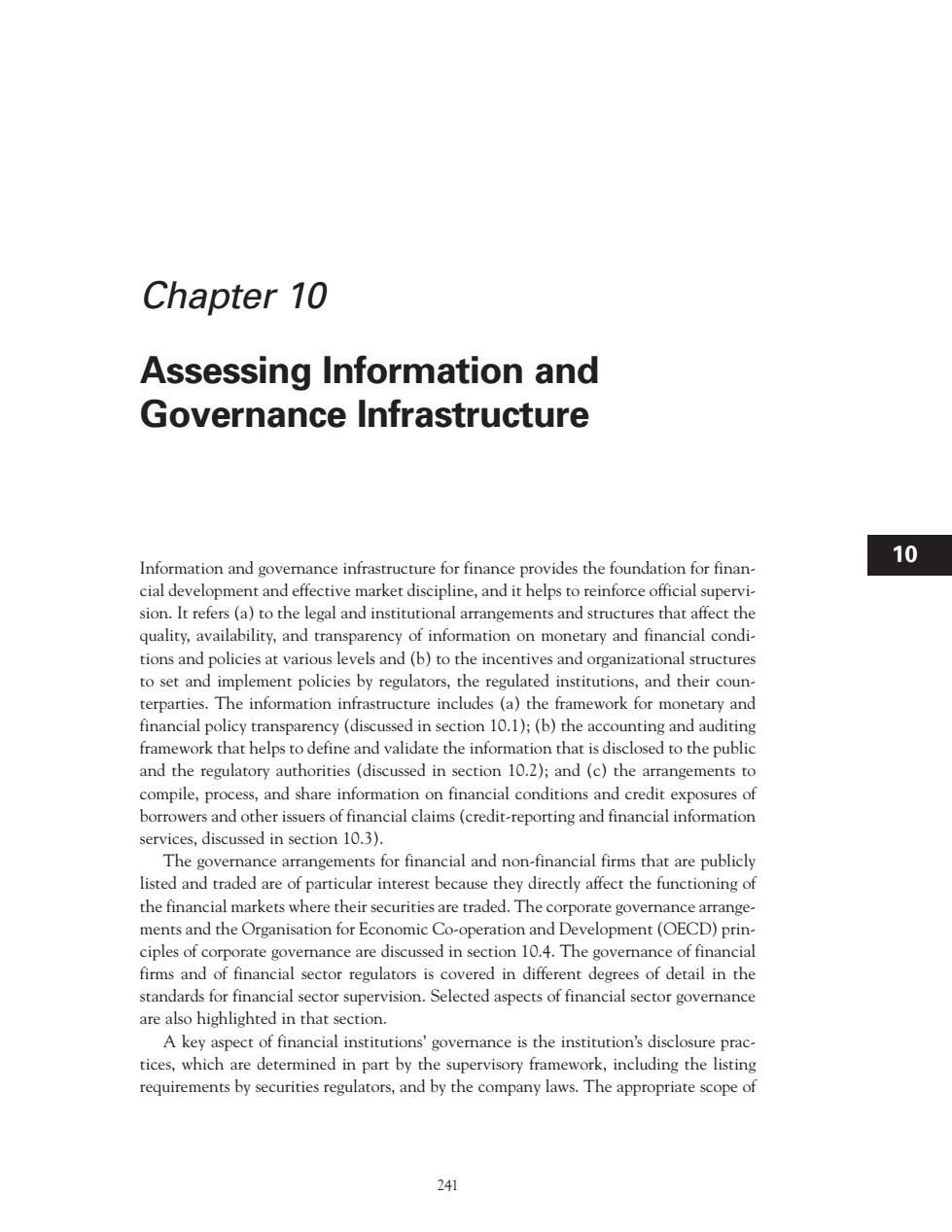正在加载图片...

Chapter 10 Assessing Information and Governance Infrastructure 10 sion.It refers(a)to the legal and institutional arrangements and structures that affect the quality,availability,and transparency of information on monetary and financial condi- tions and policies at various levels and (b)to the incentives and organizational structures to set and implement policies by regulators,the regulated institutions,and their coun- erparties.The info ormation inf cure includes (a)the framework for monetar nd financial policy transparency (discuss in section 10.1)(b)the ac contingandaud framework that helps to define and validate the information that is disclosed to the public and the regulatory authorities (discussed in section 10.2);and (c)the arrangements to compile,process,and share information on financial conditions and credit exposures of borrowers and other issuers of financial claims(credit-reporting and financial information services,discussed in section 10.3). The ents for financial and non-financial firms that are publicly listed and traded are of particular interest because they directly affect the functioningof the financial markets where their securities are traded.The corporate governance arrange- ments and the Organisation for Economic Co-operation and Development(OECD)prin- ciples of corporate governance are discussed in section 10.4.The governance of financial firms and of financial sector regulators is covered in different degrees of detail in the standards for financial sector supervision.Selected aspects of financial sector governance are also highlighted in that section. A key aspect of financial institutions'govemnance is the institution's disclosure prac- tices,which are determined in part by the supervisory framework,including the listing requirements by securities regulators,and by the company laws.The appropriate scope of241 1 I H G F E D C B A 12 11 10 9 8 7 6 5 4 3 2 Information and governance infrastructure for finance provides the foundation for financial development and effective market discipline, and it helps to reinforce official supervision. It refers (a) to the legal and institutional arrangements and structures that affect the quality, availability, and transparency of information on monetary and financial conditions and policies at various levels and (b) to the incentives and organizational structures to set and implement policies by regulators, the regulated institutions, and their counterparties. The information infrastructure includes (a) the framework for monetary and financial policy transparency (discussed in section 10.1); (b) the accounting and auditing framework that helps to define and validate the information that is disclosed to the public and the regulatory authorities (discussed in section 10.2); and (c) the arrangements to compile, process, and share information on financial conditions and credit exposures of borrowers and other issuers of financial claims (credit-reporting and financial information services, discussed in section 10.3). The governance arrangements for financial and non-financial firms that are publicly listed and traded are of particular interest because they directly affect the functioning of the financial markets where their securities are traded. The corporate governance arrangements and the Organisation for Economic Co-operation and Development (OECD) principles of corporate governance are discussed in section 10.4. The governance of financial firms and of financial sector regulators is covered in different degrees of detail in the standards for financial sector supervision. Selected aspects of financial sector governance are also highlighted in that section. A key aspect of financial institutions’ governance is the institution’s disclosure practices, which are determined in part by the supervisory framework, including the listing requirements by securities regulators, and by the company laws. The appropriate scope of Chapter 10 Assessing Information and Governance Infrastructure